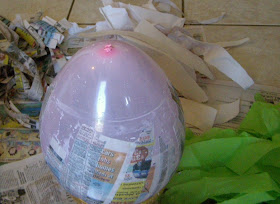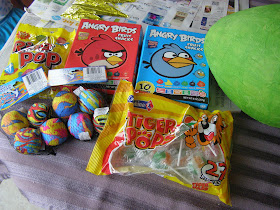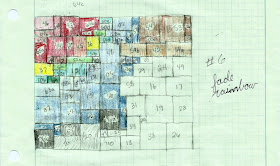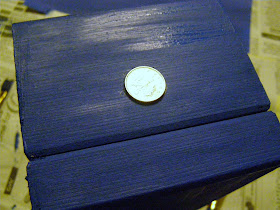We had our theme! Angry Birds! I started doing some research to see what Angry Birds party supplies were available. I suppose for party supplies, the prices weren't too bad. We didn't need a lot, since we deliberately kept the guest list very small (we rented an inflatable slide and a bouncy castle and didn't want her to have to compete with a ton of other kids for a turn). When you're used to paying $1 for 8 plates at the dollar store, the thought of paying $4 for 8 plates + shipping is a little much. And she's 2, she won't care about the plates. The 5-year-old might, but not the little one.
Here's the other problem with buying premade party supplies: the pinatas are usually pretty awful. They are made of cardboard with a cheap tissue paper exterior. Okay, maybe they're cheap and cheerful (as one of my favorite shows often says). No, on average they range from $20-$70. Pretty pricey, considering the materials cost less than $5 and it doesn't take a lot of skill to make them. Without further ado, here is my take on the Angry Birds King Pig Pinata.
Angry Birds King Pig Pinata
 | |
| Our Pinata Ingredients |
1. Gather your supplies.
To make a regular pig pinata you will need:
- Newspaper, torn into 1" wide strips
- White paper- I recycled some packing paper, but copy paper will work as well.
- Green tissue paper- 2-3 sheets
- White Glue or Craft Glue (I used Allene's Tacky Glue).*
- A Balloon, inflated with regular air and tied- round would be best, but we used an egg-shaped one.
- 1 8.5 x 11" sheet card stock
To make a king pig, you'll need the above, plus:
- Aluminum foil
- 1 8.5 x 11" sheet card stock
- 4 plastic gems, approximately 1/2-1" in diameter. We recycled some that used to be in a stepping stone.
- Tape
To make a structure for the pig to sit on, you'll need:
- Cardboard boxes of various sizes
- Contact paper that looks like marble
- Craft paper or paper grocery bags
- Packing Tape
- Brown marker
 | |
| Glue Mixture |
2. Mix your glue.
Mix equal parts glue and water in a large bowl. If the glue is a very good quality and/or very thick, increase the amount of water. I used about 1/2 cup glue and 3/4 cup water. The mixture should look and feel like whole milk.3. Apply the newspaper layer.
 | |
| Newspaper Strips in the Glue Bowl |
 |
(As a side note, I'm pretty proud of my 5-year-old who took the picture to the right and a lot of my other pictures on this post. No, I don't have a rash, that's a fading henna tattoo. )
Lay the strip of newspaper on the the balloon and smooth it down. I chose to do the first layer longitudinally. Keep applying strips, overlapping by a little bit each time. Patch any bare spots where you can still see the balloon with small or torn pieces. Also, using a second bowl to hold the balloon will help.
When that end of the balloon is fully covered, flip the balloon over and do the other side.
 |
| Laying down the first strips |
 |
| First side nearly covered |
 |
| First half finished |
 |
| Starting second half |
 | |||
| Putting on the final pieces |
4. Apply white paper layer.
 |
| Starting the white paper layer |
 | |||
| Almost done! |
5. Apply the tissue paper layer.
The tissue paper is the most fragile layer of the three. Since the white paper was pretty wet from the glue mixture, I pressed the tissue paper directly on top of it without soaking it in the glue first. Smooth any dry spots or places where the tissue paper is sticking up by spreading a little glue mixture over the spot with your fingers. | |
6. Make the crown.
If you aren't doing a king pig, skip on down to step 7.Fold your piece of card stock in half (short way), then in half again, parallel to your first fold.
Using the folds as a guide, mark and cut a zigzag line. This will give you 2 crowns to choose from. We went with the taller one.
Tear a piece of aluminum foil just a little bit longer than the crown. Place the foil shiny side down on a table. Place the crown on the foil with the top of the points about 1/4" below the edge of the foil. Fold the excess foil up over the body of the crown, making sure the bottom of the crown is in the fold line.
Cut a line from halfway between each two points of the crown to the lowest points in the "valleys" between.
Fold the cut pieces toward the crown points.
Cut off the excess and hold in place with clear tape.
Fold over the outside edges and hold in place with tape as well.
I had decided to make my life easy and just use a silver crown. But my aforementioned 5-year-old insisted we needed a gold crown and offered to do it herself. Here she is performing alchemy with a yellow sharpie.
Tape the two half-points together to make the crown. Using super glue, glue the gems in place. A word of warning- the super glue on ours reacted with the sharpie and turned bright red. One of our gems was a very pale blue and looked red on the finished product.
7. Dry the pinata.
Allow the pinata to dry until the outer shell is stiff, at least overnight. Depending on how many layers you've put on it and/or the amount of glue you've used, it may take longer.8. Fill it!
 Once the pinata is fully dry, mark a 2" square on the top of the "head."
Using a sharp knife, cut 3 sides of the square. The balloon inside will
pop with the first cut. Pull it out and discard (I had to borrow my
daughter for this step). Make sure the inside of the pinata is dry
before filling. Fill with your desired items. We used fruit snacks, soft pool balls, and lollipops. Since most of the guests were under 2, we shied away from an all-candy pinata. You could also use pencils, small bottles of bubbles, etc.
Once the pinata is fully dry, mark a 2" square on the top of the "head."
Using a sharp knife, cut 3 sides of the square. The balloon inside will
pop with the first cut. Pull it out and discard (I had to borrow my
daughter for this step). Make sure the inside of the pinata is dry
before filling. Fill with your desired items. We used fruit snacks, soft pool balls, and lollipops. Since most of the guests were under 2, we shied away from an all-candy pinata. You could also use pencils, small bottles of bubbles, etc.  |
| Our pinata filling materials |
Once the pinata is filled, seal the hole with tape. If you are not adding a crown, you will need to cover the area with another layer of tissue paper. We covered it up by putting the crown on top with masking tape.






















































